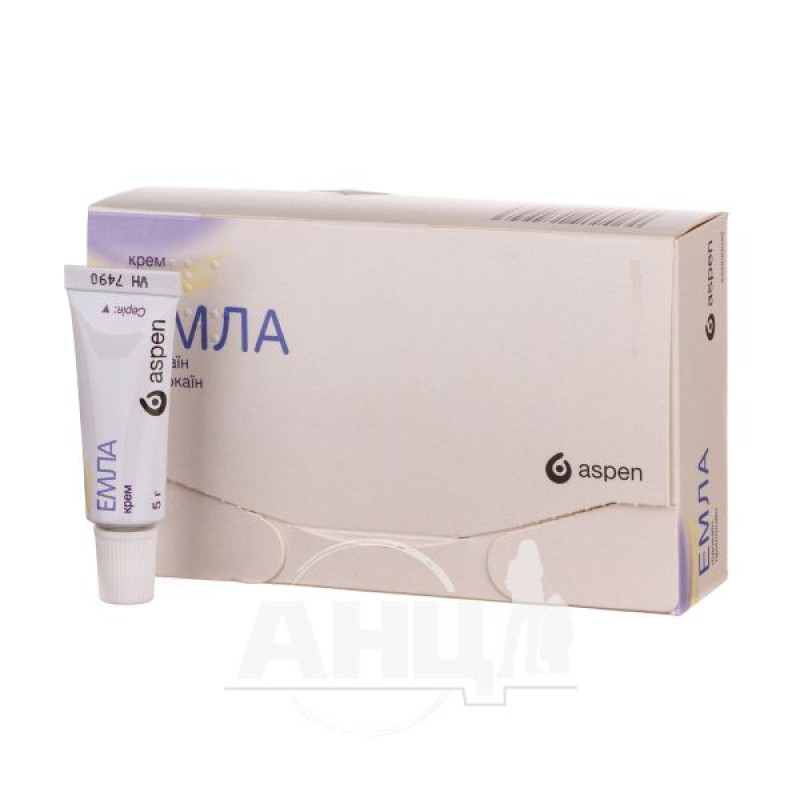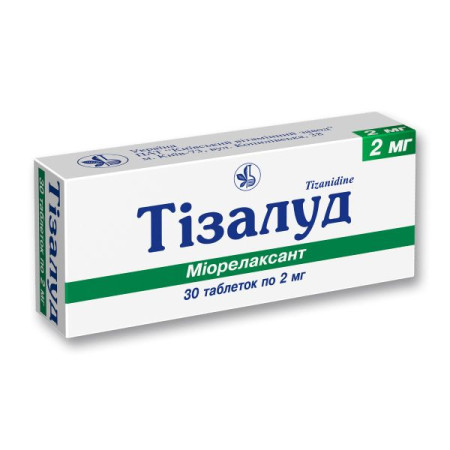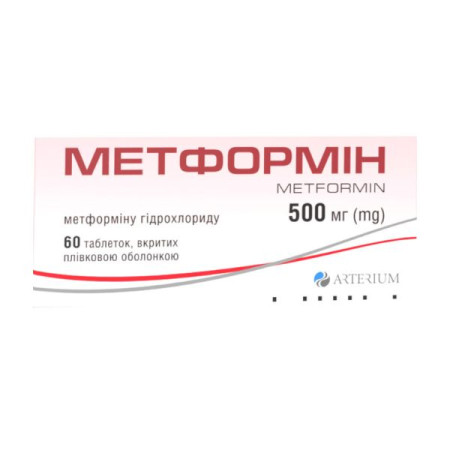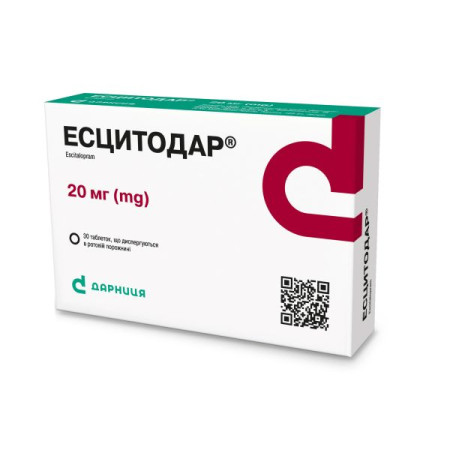Emla cream tube 5 g + 12 stickers No. 5
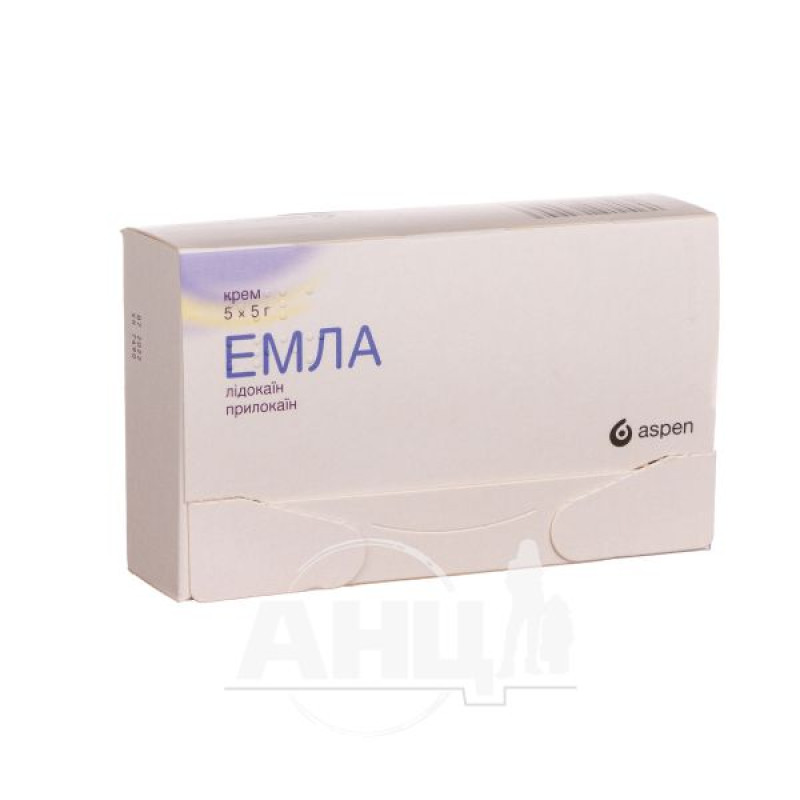
Instructions for Emla cream tube 5 g + 12 stickers No. 5
Composition
active ingredients: lidocaine, prilocaine;
1 g of cream contains: lidocaine 25 mg, prilocaine 25 mg;
Excipients: polyethoxylated hydrogenated castor oil; carbomer 974 R, sodium hydroxide, purified water.
Dosage form
Cream.
Main physicochemical properties: white, soft, homogeneous cream.
Pharmacotherapeutic group
Preparations for local anesthesia.
ATX code N01B B20.
Pharmacological properties
Pharmacodynamics.
Emla cream contains lidocaine and prilocaine, which are local anesthetics of the substituted amide group. When penetrating the epidermis and dermis, these substances provide anesthesia of the skin. The degree of anesthesia depends on the duration of application and dose.
Intact skin
With an application duration of 1–2 hours, the effect lasts for approximately two hours after removal of the occlusive dressing.
In clinical studies of the application of Emla to intact skin, no differences in safety and efficacy (including duration of anesthesia) were found between the elderly (65–96 years) and younger groups of patients.
Emla affects the superficial vasculature, which may manifest as temporary pallor or redness. This reaction develops more rapidly, within only 30–60 minutes, in patients with atopic dermatitis, indicating faster absorption through the skin.
A study in healthy volunteers with intact skin showed that in 90% of individuals, anesthesia was sufficient to insert a dermatome (4 mm diameter) to a depth of 2 mm after 60 minutes of application and to a depth of 3 mm after 120 minutes of application.
Reproductive toxicity
Lidocaine
In embryo-fetal development studies in which rats and rabbits were treated during organogenesis, no teratogenic effects were observed. Embryotoxicity was observed in rabbits at maternally toxic doses. Postnatal survival was reduced in offspring of rats exposed to maternally toxic doses during late pregnancy and lactation.
Prilocaine
Reproductive toxicity studies with prilocaine have not been completed.
A combination study in which prilocaine and lidocaine were administered to pregnant rats during the period of organogenesis showed no effects on embryo/fetal development. However, data on systemic exposure and clinical significance of the latter are insufficient.
Genotoxicity and carcinogenicity
Lidocaine
Genotoxicity studies with lidocaine have been negative. The carcinogenicity of lidocaine has not been studied. The lidocaine metabolite 2,6-xylidine has genotoxic potential in vitro. In a carcinogenicity study of 2,6-xylidine in rats in utero, postnatally and throughout life, tumors were recorded in the nasal cavity, hypodermis and liver. The clinical significance of tumor development with short-term/irregular use of lidocaine is unknown.
Prilocaine
Genotoxicity studies with prilocaine have been negative. The carcinogenicity of prilocaine has not been studied. The prilocaine metabolite ortho-toluidine has genotoxic potential in vitro. In a carcinogenicity study with ortho-toluidine in rats, mice and hamsters, tumours were observed in various organs. The clinical significance of tumours with short-term/irregular use of prilocaine is unknown.
Emla is equally effective regardless of skin color/pigmentation (skin types I–VI).
Emla can be used before subcutaneous or intramuscular vaccination. For intradermal vaccination with a live vaccine, e.g. BCG, see section "Special instructions for use".
Genital mucosa
The onset of action of the desired anesthesia is shorter because absorption occurs more quickly than when applied to intact skin.
5–10 minutes after applying Emla cream to the genital mucosa in women, local anesthesia against pain induced by argon laser lasted for 15–20 minutes (individual differences from 5 to 45 minutes).
Leg ulcers
No negative effects on ulcer healing or bacterial flora were observed.
Treatment of ulcers on the lower extremities with Emla cream provides pain relief for up to 4 hours after application.
Pharmacokinetics.
Systemic absorption of Emla depends on the amount of cream applied, exposure, skin thickness (varies in different areas of the body) and skin condition, including the presence of skin diseases (e.g. absorption is increased in atopic dermatitis) and shaving. When applied to an ulcer, the characteristics of the leg ulcer may affect absorption, for example absorption increases with increasing size of the leg ulcer.
Within 3 hours after application of 60 g of Emla cream on 400 cm2 (1.5 g on 10 cm2) on intact skin (thighs) in adults, systemic absorption was 3% for lidocaine and 5% for prilocaine. Absorption is slow. At the above dose, maximum plasma concentrations of lidocaine (average 0.12 μg/ml) and prilocaine (average 0.07 μg/ml) were reached within about 4 hours after application. The risk of toxic symptoms only exists at concentrations of 5–10 μg/ml.
In this case, shaving of the skin was performed 8–12 hours before applying the cream.
Leg ulcers
After application of 5–10 g of Emla cream for 30 minutes to leg ulcers, maximum plasma levels of lidocaine (0.05–0.84 μg/mL) and prilocaine (0.02–0.08 μg/mL) were reached after approximately 1–2.5 h.
No significant accumulation of lidocaine, prilocaine, or their metabolites in plasma was observed after repeated application of Emla to ulcers. 2–10 g of Emla cream was applied for 30–60 minutes to a maximum area of 62 cm2 for a total of 15 times in 1 month, 3–7 treatment sessions per week.
Genital mucosa
After applying 10 g of Emla cream to the vaginal mucosa for 10 minutes, maximum plasma concentrations (mean lidocaine concentrations of 0.18 μg/ml, prilocaine concentrations of 0.15 μg/ml) were observed after approximately 35 minutes.
Indication
Adults
Emla cream is used for superficial anesthesia:
skin at the injection site:
for example when taking blood samples or inserting a peripheral venous catheter;
when performing superficial surgical interventions;
mucous membranes of the genital organs, for example during superficial surgical interventions or before the administration of a local anesthetic;
trophic ulcers of the lower extremities before cleaning and performing superficial surgical interventions, for example, before removing fibrin, pus and necrotic tissues.
Children
Emla cream is used in children from birth depending on the indications in the following age groups: newborns aged 0–2 months, children aged 3–11 months and children aged 1–11 years - for superficial anesthesia of the skin at the injection site, for example, when taking blood samples or inserting a peripheral venous catheter, and when performing superficial surgical interventions. Emla cream can be prescribed to children when removing molluscum contagiosum.
Contraindication
Known hypersensitivity to local anesthetics of the substituted amide group, such as bupivacaine, etidocaine, mepivacaine or to any of the excipients. Violation of the integrity of the skin at the site of application of the cream (active herpes zoster, atopic dermatitis or wounds).
Emla should not be used:
children aged 0–12 months with concomitant use of drugs that induce the formation of methemoglobin;
premature babies (born before 37 weeks of pregnancy).
Interaction with other medicinal products and other types of interactions
Prilocaine in high doses may lead to increased methemoglobin levels, particularly in combination with drugs that induce methemoglobin formation (such as sulfonamides, nitrofurantoin, phenytoin, phenobarbital). This list is not exhaustive.
When using high doses of Emla, the risk of additive effects should be taken into account in patients using local anesthetics or drugs that are structurally similar to the latter, since the toxic effects are additive.
Specific interaction studies with lidocaine/prilocaine and class III antiarrhythmic drugs (e.g. amiodarone) have not been performed, but caution is recommended (see also section "Special warnings and precautions for use").
Drugs that reduce lidocaine clearance (e.g. cimetidine or beta-blockers) have the potential to contribute to the gradual achievement of toxic plasma concentrations with repeated use of high doses of lidocaine over a long period of time.
Children
Specific interaction studies have not been conducted in children. Interactions are likely to be similar to those in adults.
Application features
Patients with hereditary glucose-6-phosphate dehydrogenase deficiency or idiopathic methemoglobinemia are more likely to develop signs of methemoglobinemia caused by the active substance of Emla. In patients with glucose-6-phosphate dehydrogenase deficiency, the antidote methylene blue is ineffective in reducing methemoglobin levels and is itself capable of oxidizing hemoglobin, therefore treatment with methylene blue is not prescribed to such patients.
The application of the cream around the eyes requires special care, as it can cause eye irritation. Also, the loss of protective reflexes can lead to irritation and damage to the cornea. If the drug gets into the eyes, the eyes should be immediately rinsed with water or sodium chloride solution and protected until sensitivity returns.
Due to the lack of information on the absorption of the active substances, the drug should not be applied to open wounds (except trophic ulcers). Since increased absorption is possible through freshly shaved skin, it is important to adhere to the recommended dose, taking into account the site of application and duration of use (see section "Method of administration and dosage").
Caution should be exercised when using Emla cream in patients with atopic dermatitis. A shorter application time of 15-30 minutes may be sufficient. When the application time exceeds 30 minutes, local vascular reactions may occur in patients with atopic dermatitis, including redness at the application site and, in some cases, petechiae and purpura (see section 4.8). Before removing molluscum contagiosum in children with atopic dermatitis, the recommended application time is 30 minutes.
Lidocaine and prilocaine exhibit bactericidal and antiviral properties at concentrations above 0.5–2%. Therefore, the results of intradermal administration of live vaccines should be carefully monitored, although one clinical study found no effect of Emla cream on the immunization response when used before BCG vaccination, as assessed by local blistering.
Patients taking class III antiarrhythmic drugs (e.g. amiodarone) should be closely monitored. ECG monitoring should be considered in such individuals due to possible additive cardiac effects.
Emla cream contains polyethoxylated hydrogenated castor oil, which may cause skin reactions.
Children
Studies have not shown whether Emla has an analgesic effect when taking blood from the heel of newborns.
In newborns/infants up to 3 months of age, transient, clinically insignificant increases in methemoglobin levels were commonly observed within 12 hours after application of the recommended dose of Emla cream.
If the recommended dose is exceeded, the patient should be monitored for systemic adverse reactions due to methemoglobinemia (see sections “Method of administration and dosage”, “Adverse reactions” and “Overdose”).
Until sufficient clinical data are available, Emla should not be used:
children aged 0–12 months with concomitant use of drugs that induce the formation of methemoglobin;
premature infants (born before 37 weeks of gestation) - due to the risk of increased methemoglobin levels.
The safety and efficacy of Emla on the genital skin and mucous membranes in children under 12 years of age have not been established.
Available data in children do not demonstrate adequate efficacy for circumcision.
Use during pregnancy or breastfeeding
Pregnancy
Although systemic absorption is low with topical application, Emla cream should be used with caution during pregnancy due to limited data on use in pregnant women. However, animal studies do not indicate direct or indirect harmful effects with respect to pregnancy, embryofoetal development, parturition or postnatal development. Reproductive toxicity has been demonstrated with subcutaneous/intramuscular administration of high doses of lidocaine or prilocaine, when exposures were significantly higher than those with topical application.
Lidocaine and prilocaine cross the placental barrier and may be absorbed by fetal tissues. Lidocaine and prilocaine have been administered to a large number of pregnant women and women of childbearing potential. There is no evidence of reproductive toxicity, such as an increased incidence of malformations or direct or indirect effects on the fetus. However, the risk to humans has not been fully evaluated.
Animal studies with lidocaine and prilocaine are not complete with respect to pregnancy, embryonal/fetal development, parturition, and postnatal development.
It is believed that for short-term use during pregnancy, the benefits outweigh the possible risks.
Breast-feeding
Lidocaine and prilocaine pass into breast milk, but in such small quantities that at therapeutic doses there is generally no risk to the child. If clinically necessary, Emla can be used during breastfeeding.
Fertility
Animal studies have shown no effect on the fertility of male and female rats.
Ability to influence reaction speed when driving vehicles or other mechanisms
Treatment with Emla cream has no or negligible effect on reaction speed when used at recommended doses.
Method of administration and doses
Adults and adolescents 12 years and older
Intact skin
Table 1
| Indication/procedure | Dosage and method of administration | Application duration |
| For needle insertion, e.g. when inserting a venous catheter, taking blood samples | ½ tube (approximately 2 g) per 10 cm2. The cream is applied to the skin in a thick layer and an occlusive dressing is applied. | 1 hour; maximum 5 hours* |
| For minor superficial surgical procedures, such as removing molluscum contagiosum | 1.5–2 g per 10 cm2. The cream is applied to the skin in a thick layer and an occlusive dressing is applied. | |
| For larger superficial surgical procedures, such as “split flap” skin grafting | 1.5–2 g per 10 cm2. The cream is applied to the skin in a thick layer and an occlusive dressing is applied. | 2 hours; maximum 5 hours* |
| For treating large areas of freshly shaved skin (in outpatient treatment) | Maximum recommended dose: 60 g. Maximum recommended treatment area: 600 cm2. | 1 hour; maximum 5 hours* |
* After longer application, the effectiveness of anesthesia decreases.
Trophic ulcers of the lower extremities (adults only)
For cleansing trophic leg ulcers - approximately 1-2 g per 10 cm2. The cream is applied to the surface of the ulcer in a thick layer, but not more than 10 g per treatment procedure. An occlusive sticker is applied to the surface of the ulcer. The tube is intended for single use, so each time the cream remaining after the treatment procedure should be disposed of.
The duration of the application is at least 30 minutes.
For cleansing trophic ulcers in areas with tissue that is particularly difficult to penetrate, the application time may be extended to 60 minutes. Cleaning of ulcers should be carried out within 10 minutes after removal of the cream.
Emla cream was used in 15 treatment sessions over a 1–2 month period without any reduction in efficacy or increase in the number and severity of local reactions.
Superficial anesthesia of the genitals
Skin of the genitals
Apply before administering local anesthetics:
men - 1 g per 10 cm2; the cream is applied to the skin in a thick layer; application duration - 15 minutes;
women - 1–2 g per 10 cm2; the cream is applied to the skin in a thick layer; application duration - 60 minutes.
Application of Emla cream alone for 60–90 minutes to the skin of the female genitalia does not provide sufficient anesthesia for thermocoagulation or diathermy of genital warts.
Genital mucosa
Before removing warts or administering local anesthetics, approximately 5–10 g depending on the area to be treated. The entire surface, including the folds of the mucous membrane, should be covered with the cream. There is no need to apply an occlusive dressing.
The application duration is 5–10 minutes.
The procedure should be started immediately after removing the cream.
For adolescents weighing less than 20 kg, the maximum dose of Emla should be reduced proportionally when applied to the genital mucosa.
Plasma concentrations have not been determined in patients treated with doses > 10 g (see also Pharmacokinetics).
Children (0–11 years)
For needle insertion, molluscum contagiosum removal, and other minor superficial surgical procedures
1 g per 10 cm2. The cream is applied to the skin in a thick layer and an occlusive dressing is applied.
The dose should not exceed 1 gram per 10 cm2 and should be selected taking into account the area of application.
Table 2
| Age | Application area | Application duration |
| 0–2 months1,2,3 | Maximum 10 cm2 (total 1 g) (maximum daily dose) | 1 hour (no longer)4 |
| 3–11 months1,2 | Maximum 20 cm2 (total 2 g) (maximum daily dose) | 1 hour (no longer)5 |
| 1–5 years | Maximum 100 cm2 (total 10 g) (maximum daily dose) | 1 hour; maximum 5 hours6 |
| 6–11 years old | Maximum 200 cm2 (total 20 g) (maximum daily dose) | 1 hour; maximum 5 hours6 |
1 Neonates and infants up to 3 months of age should receive only 1 application in any 24-hour period. Children over 3 months of age should receive no more than 2 applications in any 24-hour period, with an interval of at least 12 hours (see sections 4.4 and 4.8).
2 For safety reasons, Emla should not be used in infants under 12 months of age who are receiving treatment with agents that stimulate the formation of methemoglobin (see sections “Special instructions for use” and “Adverse reactions”).
3 For safety reasons, Emla should not be used before 37 weeks of gestation (see section “Special warnings and precautions for use”).
4 Application lasting > 1 hour not documented.
5 No clinically significant increase in methemoglobin levels was observed after application for up to 4 hours over an area of 16 cm2.
6 After longer application, the effectiveness of anesthesia decreases.
Children with atopic dermatitis are given a cream for 30 minutes before molluscum contagiosum is removed.
The safety and efficacy of Emla on the skin and mucous membranes of the genitals in children under 12 years of age have not been established.
Available data in children do not demonstrate adequate efficacy for circumcision.
Elderly patients
Elderly patients do not need to reduce the dose.
Liver dysfunction
Patients with impaired liver function do not need to reduce the single dose.
Kidney dysfunction
Patients with impaired renal function do not need to reduce the dose.
Individuals who frequently apply or remove the cream should avoid direct contact to reduce the risk of developing hypersensitivity.
Children.
The cream is used in children from birth (see the "Indications" section).
Overdose
The development of systemic toxic effects of Emla is very unlikely when the recommended doses and route of administration are followed. It is expected that the symptoms of toxic effects will be similar to those seen with other local anesthetics, i.e. central nervous system (CNS) excitation, and in severe cases, CNS and myocardial depression.
Possible increased sweating, pale skin, dizziness, headache, blurred vision, tinnitus, diplopia, decreased blood pressure, bradycardia, arrhythmia, drowsiness, chills, numbness of the extremities, anxiety, convulsions, shock, cardiac arrest.
Rare cases of clinically significant methemoglobinemia have been reported. The use of prilocaine in high doses may increase methemoglobin levels, especially in susceptible individuals (see section 4.4), when administered too frequently to neonates and infants under 12 months of age (see section 4.2), and when administered concomitantly with drugs that induce methemoglobin formation (such as sulfonamides, nitrofurantoin, phenytoin, and phenobarbital). It should be noted that pulse oximeter readings may overestimate actual oxygen saturation if the methemoglobin fraction is increased; therefore, if methemoglobinemia is suspected, it is preferable to monitor oxygen saturation by CO-oximetry.
Topical application of 125 mg of prilocaine for 5 hours caused moderate methemoglobinemia in a 3-month-old child. Topical application of lidocaine at a dose of 8.6–17.2 mg/kg caused extremely severe intoxication in children.
For the treatment of clinically significant methemoglobinemia, slow intravenous injection of methylene blue should be used (see also section "Special instructions").
Severe neurological symptoms (convulsions, CNS depression) require symptomatic treatment, including artificial ventilation and administration of anticonvulsants, circulatory disorders should be treated according to recommendations for resuscitation measures. The antidote for methemoglobinemia is methylthioninium. Due to slow systemic absorption, a patient with symptoms of poisoning should be monitored for several hours after immediate treatment of these symptoms.
With the appearance of the first signs of intoxication (dizziness, nausea, vomiting, euphoria), transfer the patient to a horizontal position; prescribe oxygen inhalation; for bradycardia - M-cholinoblockers (atropine), vasoconstrictors (norepinephrine, phenylephrine).
Other symptoms of systemic toxicity may be similar in nature to those seen with local anesthetics administered by other routes. Toxicity with local anesthetics is manifested by nervous system excitation and, in severe cases, central nervous system and cardiovascular depression.
Side effects
Summary of safety profile
The most frequently observed adverse reactions are related to conditions at the injection site (transient application site reactions), which have been reported frequently.
List of adverse reactions
The frequency of adverse reactions associated with the use of Emla is listed in the table below and is based on adverse event data reported in clinical trials and/or during post-marketing use. Adverse reactions are listed by MedDRA (Medical Dictionary for Regulatory Activities) system organ class and preferred term level.
The frequency is defined as follows: very common (≥ 1/10), common (≥ 1/100, < 1/10), uncommon (≥ 1/1,000, < 1/100), rare (≥ 1/10,000, < 1/1,000), very rare (< 1/10,000). Within each frequency grouping, adverse reactions are presented in order of decreasing seriousness.
Table 3
| Blood and lymphatic system disorders | Rarely | Methemoglobinemia1 |
| Immune system disorders | Rarely | Hypersensitivity1, 2, 3 |
| Visual impairment | Rarely | Corneal irritation1 |
| Skin and subcutaneous tissue disorders | Rarely | Purpura1, petechiae1 (especially with long-term application in children with atopic dermatitis or molluscum contagiosum) |
| General disorders and administration site conditions | Often | Burning sensation2,3, itching at the application site2,3, redness at the application site1,2,3, swelling at the application site1,2,3, warmth at the application site2,3, pallor at the application site1,2,3 |
| Infrequently | Burning sensation1, application site irritation3, application site itching1, application site paraesthesia2 such as tingling, application site warmth1 |
1 intact skin
2 mucous membranes of the genitals
3 trophic ulcers of the lower extremities
In the event of overdose, rapid absorption or hypersensitivity, adverse reactions are expected to be similar in nature to those observed after administration of amide-type local anesthetics by other routes.
The frequency, type and severity of adverse reactions were similar in the paediatric and adult age groups, with the exception of methaemoglobinaemia, which was more frequently observed in neonates and infants aged 0–12 months, often in association with overdose (see section 4.8).
Reporting of suspected adverse reactions
Reporting suspected adverse reactions after a medicinal product has been authorised is important. This allows for continued monitoring of the benefit/risk balance of the medicinal product. Healthcare professionals should report any suspected adverse reactions through the national pharmacovigilance system.
Expiration date
3 years.
Storage conditions
Store at a temperature not exceeding 30 ° C. Do not freeze.
Keep out of reach of children.
Packaging
5 g in a tube; 5 tubes together with 12 occlusive stickers in a cardboard box;
30 g in a tube; 1 tube in a cardboard box.
Vacation category
Without a prescription.
Producer
Recifarm Karlskoga AB.
Aspen Bad Oldesloh GmbH.
Location of the manufacturer and address of its place of business.
Björkbornsvegen 5, Karlskoga, 69133, Sweden.
Industristrasse 32 - 36, 23843 Bad Oldesloe, Germany.
There are no reviews for this product.
There are no reviews for this product, be the first to leave your review.
No questions about this product, be the first and ask your question.



